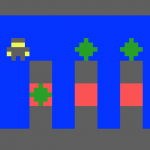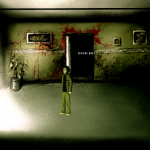Pathos (2011)
June 16, 2011 - Features
The relationship between the player and the avatar varies a lot between games. Sometimes the avatar character is meant to be an unembellished extension of the player, as in any first-person game with a faceless, voiceless protagonist. Those are increasingly rare in mainstream games, however. Usually the avatar has some character of her own, whether this is a character that the player mostly determines or one fixed by the designer. The more fixed characters can lead to a strange experience of a game. This is particularly true when the player feels disconnected from the avatar character, as Michael Abbot recently discussed in relation to LA Noire‘s Cole Phelps.
Sash Mackinnon’s Pathos is a short game that takes this disconnect even further. The avatar character is a boy who jumps into a mysterious light in his room at bedtime. You can occasionally control him by clicking your mouse, but much of the time he stands in place talking to himself. When you try to click during these periods, a “No” icon flashes in the corner of the screen. Later you spur him onwards by shutting off lights behind him or clicking a button to lower a platform.
The disconnect comes not only from this limited interaction but also from the fact that the boy is increasingly terrified of you and your manipulations of him. In the end, you get an avatar of your own and chase the boy down, revealing that you were the monster under the bed all along. Mackinnon has stated that he intended the awkward interaction to be a metaphor for this adversarial relationship. The limited controls are meant to be frustrating at first, until you realize that you really are moving the boy against his will.
This raises the question of who exactly the protagonist is in this story. If the protagonist is the central character that the audience most identifies with, we clearly have two candidates here. The boy arouses more sympathy: he is telling us his thoughts, we can see his facial expressions, and he’s a scared little kid. The monster is an obvious villain, but it’s also the character the player controls. And while we don’t hear the monster’s inner thoughts, we are manipulated into sharing them. We get impatient with the boy’s slowness, and frustrated with our inability to control him. We may identify with the boy emotionally while identifying with the monster in a more direct way.
Pathos is a simple game, but it does a good job of pointing out that traditional definitions of protagonists and antagonists may need to be expanded a bit when it comes to game stories. What does identification mean when it comes to game characters? Is the avatar always the hero? Is the player? These are questions that bear more investigation.



